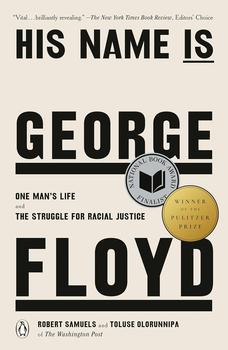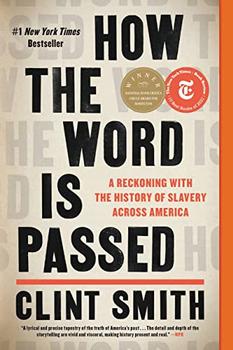Summary | Excerpt | Reading Guide | Reviews | Beyond the book | Read-Alikes | Genres & Themes | Author Bio

One Man's Life and the Struggle for Racial Justice
by Robert Samuels, Toluse OlorunnipaThe murder of George Floyd on May 25, 2020, sparked a worldwide movement of protest against police brutality and wider forces of systemic racism, and in the process Floyd sometimes became more of a symbol than a person. Robert Samuels and Toluse Olorunnipa go beyond the marches and murals to reveal the man who was George Floyd, while also shining a light on the social, economic and political forces that frame and shape the country in which he lived and died. The result is a richly detailed biography along with a social history of modern America.
Through meticulous research, the authors begin their exploration of George Perry Floyd Jr. by examining his family history, starting with his ancestors at emancipation. Floyd's great-great-great-grandfather, Hillery Thomas Stewart, owned hundreds of acres in North Carolina and was building wealth in the Reconstruction-era South, despite being illiterate due to slave codes that forbade Black people from learning to read (see Beyond the Book). In an all-too-common scenario, however, the Stewarts had their land repossessed and sold off after "signing" complex financial documents they couldn't read. This dispossession of Black wealth after Reconstruction — essentially post-1876 — affected Floyd's family like it did countless other Black families, leaving them in poverty and preventing the intergenerational transfer of wealth that persists in today's gap between the average wealth of white and Black Americans.
Samuels and Olorunnipa follow the Floyd family from the grinding poverty of the North Carolina tobacco fields to Houston, Texas, where Floyd's mother moved with her children in 1977. There they found a highly segregated city where white residents and leaders had stymied efforts at integrating schools for decades following the Brown v. Board of Education ruling.
The result was a massive lack of resources for the predominantly Black schools that Floyd attended. Interviews with his former teachers and coaches reveal a boy who struggled academically yet excelled athletically, falling into a recognized pattern where young Black men view sports as their only way out of the cycle of poverty. When he couldn't pass the required tests to graduate, there were no programs or tutors to help teenage George Floyd, and his grades made him ineligible for playing college athletics despite his basketball scholarship from a community college. With his sports ambitions closed off, Floyd soon slipped into the criminal justice system, the second half of the pernicious school-to-prison pipeline.
The authors don't flinch from Floyd's mistakes with dealing and using drugs, but their copious interviews with his friends and family members paint a fully formed picture of an imperfect yet kind and thoughtful person. Their diligence in reporting from those who knew Floyd intimately as well as religious leaders, police officers and scholars creates a seamless narrative of Floyd's life embedded within larger forces of over-incarceration, a lack of job opportunities for those with a criminal record, and ever-present poverty with its associated stress and health damages. They move elegantly from personal remembrances and specific moments in his life to discussions of systemic roadblocks, giving the reader a personal and social history that is both honest and measured.
The narrative moves with Floyd to Minneapolis, Minnesota, where he tried to get clean and move on from his past. He struggled, however, to overcome the same personal issues that affected him in Houston, as well as systemic discrimination in areas such as job opportunities and policing. The authors recount the details of his brutal murder along with the cries and protests of the witnesses, giving the reader a chilling and up-close view — a feeling of being in that well-known video themselves.
But they quickly shift focus to the protests for justice and why this murder of an unarmed Black man by police, among so many others, sparked such a widespread reaction: "Now in the throes of a pandemic, with sporting events canceled and schools closed and edicts to stay inside, the country could not look away from this videotaped incident of police brutality as easily as it had with others." The growth of support for the Black Lives Matter movement and the attendant backlash are catalogued with eyewitness accounts from protests, including from other Black families who lost a loved one to police violence.
Samuels and Olorunnipa also detail the effects on George Floyd's family, particularly his brother Philonise, from the excruciating trial to being thrust into the limelight of national speaking appearances and meeting with activists, celebrities and politicians. This section of the book, like the previous ones, captures the pain, turmoil and hope of those who are suffering while embedding the personal into a larger framework. Politics, the pandemic and public apathy eventually converged to prevent meaningful changes, but the authors deftly close with a cautiously optimistic and historically centered assessment of George Floyd's death and its impact on American society writ large.
Eloquently told and expertly navigating the emotion and polarization that calcified after his murder, His Name Is George Floyd leaves readers better educated than it finds them and humanizes the man whose murder has been and can remain a catalyst for change.
![]() This review was originally published in The BookBrowse Review in June 2022, and has been updated for the
June 2024 edition.
Click here to go to this issue.
This review was originally published in The BookBrowse Review in June 2022, and has been updated for the
June 2024 edition.
Click here to go to this issue.

If you liked His Name Is George Floyd, try these:

by Kellie Carter Jackson
Published 2025
A radical reframing of the past and present of Black resistance—both nonviolent and violent—to white supremacy.

by Clint Smith
Published 2022
The Atlantic staff writer and poet Clint Smith's revealing, contemporary portrait of America as a slave owning nation.
Your guide toexceptional books
BookBrowse seeks out and recommends the best in contemporary fiction and nonfiction—books that not only engage and entertain but also deepen our understanding of ourselves and the world around us.